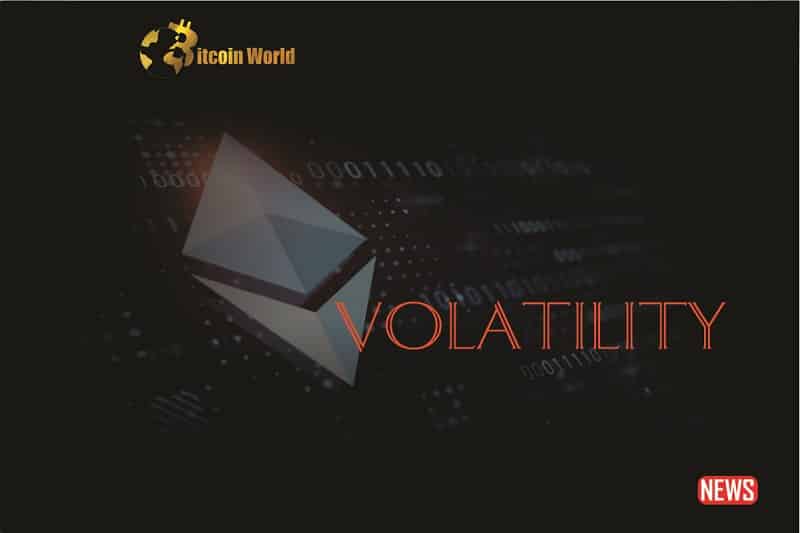Ever noticed how anticipation builds before a major Ethereum upgrade, often reflected in a surge of its Implied Volatility (IV)? It’s like the market bracing itself for potential shifts. But lately, the narrative around Ethereum’s volatility has taken an interesting turn.
Ethereum’s IV Hits a New Low: What Does It Mean?
Here’s the scoop: the long-term implied volatility for ETH ‘at-the-money’ (ATM) options has plummeted to a historic low of 50%, according to data from GreeksLive. Interestingly, this puts ETH’s IV right on par with Bitcoin’s. So, what does this tell us?
- Market Expectations Align: It suggests that the market is now pricing in similar future volatility for both Ethereum and Bitcoin.
- Reduced Anticipation of Price Swings: A drop in IV generally signals that market participants anticipate less dramatic price fluctuations for the asset in the near future.
Think of it this way: Implied Volatility (IV) is essentially the market’s best guess on how much an asset’s price might swing, derived from the prices of its options contracts. When IV drops for ETH, it’s like the market collectively saying, “We don’t expect as much turbulence ahead.”
But Here’s the Twist: The Rising Put-to-Call Ratio
Despite this apparent calmness in implied volatility, another metric is painting a slightly different picture: the put-to-call ratio for Ethereum is on the rise across various exchanges. Confused? Let’s break it down:
- Put Options: These give the buyer the right, but not the obligation, to sell ETH at a specific price (the strike price) by a certain date. They’re often used to hedge against potential price drops or to bet on a downturn.
- Call Options: Conversely, these give the buyer the right to buy ETH at a specific price by a certain date. They’re typically used to profit from anticipated price increases.
- Put-to-Call Ratio: This ratio compares the volume of put options being bought to the volume of call options. A rising ratio suggests increased demand for put options.
So, a growing put-to-call ratio for ETH, despite low IV, hints that market participants are becoming more pessimistic about its future price. They’re buying more ‘insurance’ against a potential price decrease or actively betting on it.
Why the Pessimism? Enter the Ethereum Foundation
You might be wondering what’s fueling this undercurrent of negativity. Well, the recent actions of the Ethereum Foundation might be a contributing factor.
For those unfamiliar, the Ethereum Foundation is a non-profit organization dedicated to supporting the growth and development of the Ethereum blockchain and its ecosystem. Recently, the Foundation disclosed the sale of 15,000 ETH. Historically, similar sales by the Foundation have coincided with dips in ETH’s market value.
Consider this:
| Factor | Potential Impact |
|---|---|
| Ethereum Foundation selling ETH | Can be interpreted as a lack of confidence or a need to secure funding, potentially triggering sell-offs in the market. |
| Increased Put-to-Call Ratio | Indicates a higher number of investors hedging against price drops or actively betting on a decline. |
| Low Implied Volatility | While suggesting less expected price swings, it could also be a calm before a storm, with the market positioned for a potential downside move. |
The Ripple Effect: Declining NFT Trades and Gas Use
The impact isn’t limited to price speculation. On-chain activity on the Ethereum network has also seen a downturn. The number of NFT trades has significantly decreased over the past month, leading to a reduction in gas use.
Think of gas as the transaction fee on the Ethereum network. Lower gas use generally indicates less activity. While lower fees might sound good on the surface, a sustained decline in network activity can have negative consequences in the long run.
- Reduced Revenue for Validators: Lower gas fees mean less income for the network’s validators, who are crucial for its security and operation.
- Potential Impact on Future Development: A less active network might attract fewer developers and projects, potentially hindering future growth.
Navigating the Current Landscape: Actionable Insights
So, what can we glean from this confluence of events?
- Stay Informed: Keep a close eye on both implied volatility and the put-to-call ratio for Ethereum. These are key indicators of market sentiment.
- Understand the Ethereum Foundation’s Role: Monitor the Foundation’s activities and communications, as their actions can significantly influence the market.
- Consider Network Activity: Track metrics like NFT trade volume and gas use to gauge the overall health and engagement with the Ethereum ecosystem.
- Manage Risk: In times of uncertainty, consider strategies to manage your risk, such as diversifying your portfolio or using options to hedge your positions.
Looking Ahead
The current situation with Ethereum presents a fascinating dynamic. While the low implied volatility might suggest a period of relative stability, the rising put-to-call ratio and the Ethereum Foundation’s recent actions hint at underlying bearish sentiment. The decline in NFT trades and gas use adds another layer of complexity to the narrative.
Ultimately, the cryptocurrency market is known for its volatility and unexpected turns. Staying informed, understanding the underlying metrics, and managing risk are crucial for navigating these dynamic waters. Whether this period of low volatility is a temporary lull or a precursor to a significant shift remains to be seen. Keep watching the charts, stay informed, and be prepared for either scenario.
Disclaimer: The information provided is not trading advice, Bitcoinworld.co.in holds no liability for any investments made based on the information provided on this page. We strongly recommend independent research and/or consultation with a qualified professional before making any investment decisions.


